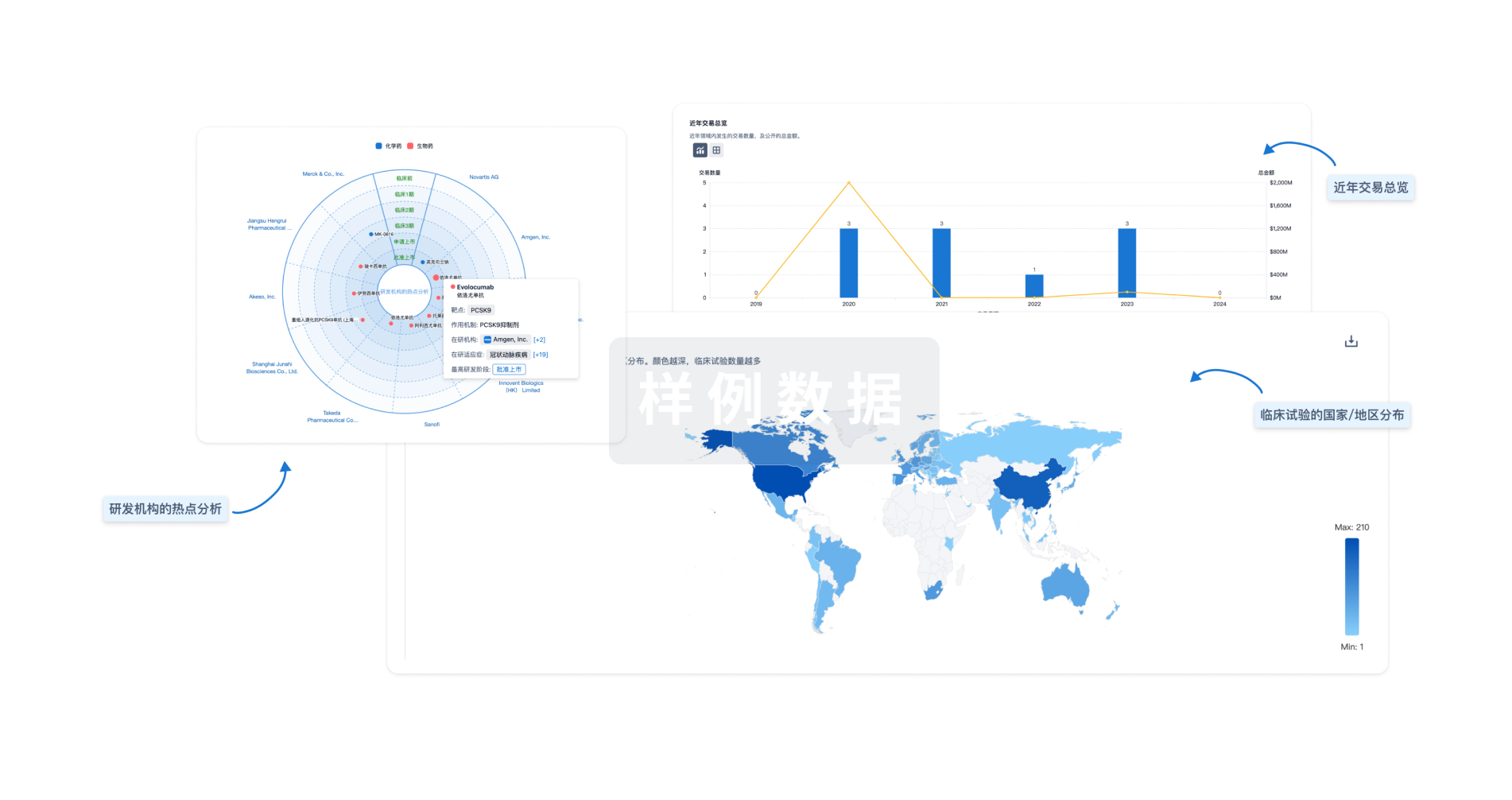预约演示
更新于:2025-05-07
CLASRP
更新于:2025-05-07
基本信息
别名 CLASP、CLASRP、CLK4 associating serine/arginine rich protein + [5] |
简介 Probably functions as an alternative splicing regulator. May regulate the mRNA splicing of genes such as CLK1. May act by regulating members of the CLK kinase family (By similarity). |
关联
100 项与 CLASRP 相关的临床结果
登录后查看更多信息
100 项与 CLASRP 相关的转化医学
登录后查看更多信息
0 项与 CLASRP 相关的专利(医药)
登录后查看更多信息
147
项与 CLASRP 相关的文献(医药)2025-03-01·Current Biology
Asymmetric microtubule nucleation from Golgi stacks promotes opposite microtubule polarity in axons and dendrites
Article
作者: Yagoubat, Akila ; Conduit, Paul T
2025-03-01·Molecular Plant
The plant retromer components SNXs bind to ATG8 and CLASP to mediate autophagosome movement along microtubules
Article
作者: Zheng, Xuanang ; Li, Ruixi ; Kang, Byung-Ho ; Ma, Wenlong ; Zhou, Jun ; Li, Hongbo ; Liu, Chuanliang ; Gao, Caiji ; Kuang, Jiayi ; Li, Xibao ; Li, Faqiang ; Li, Zien ; Lin, Xinyi ; Qiao, Fanfan ; Liao, Yanglan
2025-02-01·Current Computer-Aided Drug Design
Comprehensive In Silico Analysis of Uncaria Tomentosa Extract: Chemical Profiling, Antioxidant Assessment, and CLASP Protein Interaction for Drug Design in Neurodegenerative Diseases
Article
作者: Panda, Siva Prasad ; Kumar, Sanjesh
4
项与 CLASRP 相关的新闻(医药)2025-01-08
·药明康德
▎药明康德内容团队编辑
今日,生物医药行业知名媒体网站BioSpace评选出2025年度新一代生物新锐公司(NextGen Class of 2025)。通过对公司的融资情况、合作、研发管线、成长潜力以及创新方面进行综合评估,BioSpace选出上榜的生命科学新锐。今年上榜的25家新锐充分体现了新治疗模式和创新药物开发策略对新药开发的影响,其专注领域广泛,包含基因疗法、细胞疗法、RNA疗法,核药以及创新小分子等不同模式。药明康德内容团队根据该报道,并结合公开资料,向读者们介绍这些生物科学领域的亮眼新星。
1. ARTBIO
ARTBIO是一家临床阶段的放射性医药公司,通过创建一类新的α放射性配体疗法(ARTs)来改善癌症治疗。该公司的独特技术在于选择释放α粒子的同位素(Pb212)和肿瘤特异性靶标,以开发高效且安全的抗癌疗法。其AlphaDirect技术平台是一种创新的Pb212分离方法,能够通过分布式制造网络以达成ART的可靠生产和交付。该公司在2023年12月完成9000万美元A轮融资,其主打在研疗法AB001已经进入临床试验,用于治疗前列腺癌。
▲ARTBIO首席执行官Emanuele Ostuni博士在药明康德BOLD系列活动中分享洞见(图片来源:药明康德内容团队)
该公司首席执行官Emanuele Ostuni博士在药明康德BOLD系列活动中表示,每年上千万癌症患者接受化疗或全身性放射性治疗,这些疗法的副作用较大。而α放射性配体疗法将放射性同位素选择性地带入肿瘤,在杀伤癌细胞的同时避免对健康组织的损伤。
2. Clasp Therapeutics
Clasp专注于开发针对每例患者免疫系统量身定制的模块化T细胞接合器(TCE),这些TCE为现货型、双特异性抗体样分子,旨在同时靶向T细胞表面的CD3蛋白与癌细胞表面的肿瘤特异性突变肽,以促进T细胞对癌细胞的攻击。这些肿瘤特异性突变肽由具有患者免疫特征的HLA所呈现。Clasp的TCE靶向常见的致癌驱动突变,可用以治疗多种难治的肿瘤类型。这种疗法的关键在于Clasp能够通过专注于常见的肿瘤特异性驱动突变(包括许多对标准免疫疗法无应答的突变)来选择接受治疗的患者。通过以高度特异性方式将T细胞和肿瘤细胞结合,这种疗法可确保针对肿瘤本身的免疫激活,同时避免损害不含肿瘤特异性突变肽的正常组织。该公司在去年3月完成1.5亿美元A轮融资。
3. COUR Pharmaceuticals
COUR致力于开发治疗自身免疫性和炎症性疾病的疗法。其潜在“first-in-class”疗法基于专有的抗原特异性免疫耐受平台,旨在对免疫系统进行重新编程,以解决免疫介导疾病的根本原因。来自多个临床和临床前项目的数据表明,COUR的候选产品能够诱导抗原特异性免疫耐受,具有治疗多种自身免疫性和炎症性疾病的潜力。其主打在研产品目前正在2期临床试验中接受检验,治疗原发性胆汁性胆管炎和重症肌无力。该公司去年12月与罗氏达成潜在超9亿美元的研发合作。
4. Delphia Therapeutics
Delphia的科学创始人发现,很多致癌基因的信号通路对过度激活格外敏感。致癌基因的过度激活会导致细胞的应激通路不堪重负,最终导致携带这些突变的癌细胞选择性死亡。这些弱点为靶向特定调节节点,驱动信号通路过度激活而选择性杀伤肿瘤细胞提供了机会。该公司在去年5月宣布完成6700万美元的A轮融资。获得资金将用于基于其创新的激活致死(activation lethality)原理,开发具有高度差异性的潜在“first-in-class”靶向抗癌疗法。它们可能具有显著抗癌活性并且为多种常见癌症患者提供持久获益。
5. Diagonal Therapeutics
Diagonal公司致力于发现和开发激动性抗体(agonist antibody),通过结合两个受体并将它们聚集在一起来激活信号通路。利用其专有平台,该公司已经发现了针对四个复杂靶标的候选抗体,为治疗多种严重疾病提供了新的途径,其中治疗遗传性出血性毛细血管扩张症和肺动脉高压的在研疗法处于临床前开发阶段。去年3月,该公司完成1.28亿美元A轮融资。
6. Exsilio Therapeutics
Exsilio的跨学科团队已经建立了一个药物发现和开发平台,结合预测性的计算机模型和传统实验,以发现和设计将治疗性基因整合到安全位点的疗法。由于Exsilio的疗法使用mRNA编码,它们可以使用现有的脂质纳米颗粒(LNP)平台进行递送。这些平台具有安全、高效、可扩展且成本效益高等多种特征。该公司在去年6月完成8200万美元的A轮融资。
7. Firefly Bio
Firefly Bio由诺贝尔化学奖得主Carolyn Bertozzi教授联合创建,致力于开发蛋白降解偶联药物(DAC)。其平台使用强大的蛋白质降解剂作为药物的有效载荷,并使用其所开发的专有连接子将它们与抗体相连,这种专有连接子能够减少自DAC脱落进入血液循环中的载荷,并最大限度地减少健康细胞的吸收。这样的设计使达到最佳有效性所需的药物剂量降低。根据在实体瘤和血液肿瘤的临床前研究数据,单次使用Firefly的DAC即可在极低剂量下显著缩小肿瘤负荷。该公司在去年2月完成9400万美元的A轮融资。
8. GC Therapeutics
GC Therapeutics由哈佛医学院和Wyss研究所的George Church博士联合创建,致力于规模化和解锁下一代细胞疗法。该公司的诱导多能干细胞(iPSC)编程平台TFome融合了合成生物学、基因编辑、细胞工程和机器学习领域的最新进展,能够识别优化的转录因子组合,将iPSCs分化为几乎任何功能性细胞类型。TFome旨在改进细胞疗法的效力、效率、质量和成本。这一方法可能以比传统细胞分化方法快100倍的速度,生产出潜在“first-in-class”和“best-in-class”的现货型细胞治疗产品。该公司在去年9月完成6500万美元A轮融资。
9. GondolaBio
GondolaBio是BridgeBio Pharma公司成立的一家新公司,它获得投资者3亿美元的支持。BridgeBio Pharma公司将把针对红细胞生成性原卟啉症、α-1抗胰蛋白酶缺乏症和结节性硬化症的早期临床期和临床前项目转移到GondolaBio公司并由其继续进行开发。
10. Kenai Therapeutics
Kenai公司致力于开发基于诱导多能干细胞的细胞疗法,治疗多种神经系统疾病。该公司在去年2月完成8200万美元A轮融资。获得资金将用于推进其主打项目同种异体多巴胺前体细胞疗法RNDP-001进入临床,以治疗帕金森病患者。
Kenai公司首席医学官Howard Federoff博士在接受药明康德内容团队采访时表示,该公司希望通过大量的临床和神经影像学证据证明,RNDP-001能够让患者大脑的神经回路获得重建,而这可能将疾病逆转至早期阶段,甚至减少或消除某些患者对现有药物的依赖。
▲Kenai Therapeutics首席医学官Howard Federoff博士(图片来源:药明康德内容团队)
11. Latigo Biotherapeutics
Latigo的主打项目LTG-001是一种口服选择性Nav1.8抑制剂,目前正在健康志愿者中进行1期临床试验,旨在治疗急性和慢性疼痛。LTG-001具有起效快、疗效显著、安全性优于标准治疗且不影响中枢神经系统等优点,有望成为“best-in-class”药物。除了LTG-001之外,该公司还拥有一套Nav1.8抑制剂,使Latigo能够在临床中发挥此类靶点的广泛潜力。该公司在去年2月完成1.35亿美元的A轮融资。
12. Latus Bio
Latus的专有技术旨在通过直接在非人灵长类动物中大规模和无偏倚地筛选新型腺相关病毒(AAV)衣壳,以应对现有以AAV为载体的基因疗法所面临的挑战,包括对高剂量注射的依赖、高剂量注射可能引起的脱靶毒性,以及难以进行规模化生产等问题。在临床前非人灵长类动物模型中,该公司的衣壳变体在中枢神经系统中的精确部位表现出高基因表达,具有靶细胞特异性,且组织外活性极低。基于这些临床前数据,Latus公司计划在临床研究中使用低剂量的候选产品,旨在提高基因疗法的安全性并实现成功生产。该公司去年5月完成5400万美元的A轮融资。
13. Marea Therapeutics
Marea公司致力于开发用于治疗心脏代谢疾病的新一代药物。其主打在研项目MAR001是一种潜在"first-in-class"的单克隆抗体,靶向在脂肪组织中高度表达的ANGPTL4蛋白。MAR001通过抑制ANGPTL4,从而优先增强脂肪组织中的脂蛋白脂肪酶(LPL)活性,进而降低残留胆固醇,改善脂肪组织和代谢功能,并减少心血管事件。该公司在去年6月完成1.9亿美元的A、B轮融资。
14. Metsera
Metsera公司致力于开发治疗肥胖症,以及肥胖和代谢相关疾病的产品组合。2024年4月,该公司宣布完成2.9亿美元融资。Metsera的新一代注射和口服药物开发项目组合源自该公司专有的2万多种肠激素肽和肽/抗体偶联物库。该公司重点关注多项新一代靶点和组合疗法。今日,该公司宣布其主打项目超长效皮下注射GLP-1受体激动剂(GLP-1RA)MET-097i在一项2a期试验中获得积极数据。在试验12周,患者的体重降幅最高可达20%,且药代动力学结果显示该药物具有每月一次给药潜力。
15. Mirador Therapeutics
Mirador Therapeutics在2024年3月宣布走出隐匿模式并完成超过4亿美元融资。Mirador旨在通过利用其专有的Mirador360开发引擎,快速推进多个项目,从而彻底改变免疫介导的炎症性和纤维化疾病的精准医疗。Mirador专注于开发潜在“first-in-class”或“best-in-class”的精准医学药物。Mirador的专有Mirador360平台结合了人类遗传学和尖端数据科学的最新突破,能够分析数百万患者的分子谱,以发现和验证与免疫纤维化疾病相关的遗传信息、识别新的治疗靶点、阐明靶点之间的相互作用并发现潜在联合疗法的最佳靶点配对。此外,Mirador360还能协助Mirador开发诊断测试,并对患者群体进行分层,以实现精准的临床开发。
16. nChroma Bio
上个月,Chroma Medicine公司和Nvelop Therapeutics公司宣布合并成立nChroma Bio公司,将表观遗传编辑技术和下一代体内递送技术相结合,以重新定义基因药物的未来。在合并的同时,nChroma公司还完成了7500万美元的超额认购融资,为公司提供额外的资金,以推动其主导项目获得有意义的临床数据,并建立强大的下一代肝脏和肝外靶向治疗管线。该公司的主导项目CRMA-1001是一种肝脏靶向表观遗传编辑疗法,具有潜在“best-in-class”的效力和推动慢性乙型肝炎和丁型肝炎功能性治愈的潜力。17. 昂阔医药(OnCusp Therapeutics)
去年1月,昂阔医药宣布完成超额认购的1亿美元(超7亿人民币)A轮融资。此次融资所得款项将用于推进一款靶向CDH6的抗体偶联药物(ADC)CUSP06的临床开发,以及用于公司产品管线和团队的建设。昂阔医药由袁斌博士、Eric Slosberg博士和富天博士共同创立,是一家致力于将肿瘤前沿药物转化为创新疗法的生物医药公司。该公司的主打产品CUSP06具有可针对多种恶性实体肿瘤进行治疗的潜力。CUSP06目前正在美国进行1期临床试验。
18. OrsoBio
OrsoBio在去年9月成功完成6700万美元的B轮超额融资,筹集的资金预计用于加速公司线粒体质子载体(mitochondrial protonophore)产品组合的开发,用以治疗肥胖及相关代谢疾病。公司将推进其在研减重疗法TLC-6740进入后期临床试验。TLC-6740是一款新型口服、肝脏靶向的线粒体质子载体,正在一项针对肥胖患者、为期12周的1b期临床试验中进行评估。而该公司旗下两款质子载体TLC-1180和TLC-1235的IND支持研究则预计将在2025年完成。TLC-1180是一种强效、长效的线粒体质子载体,适合每周口服或皮下注射。TLC-1235是一种控制释放的线粒体质子载体(CRMP),在多个模型和物种中显示出代谢益处。
19. Radionetics Oncology
Radionetics Oncology是一家处于临床阶段的放射性药物公司,专注于发现和开发针对各种肿瘤适应症的新型放射性药物。该公司正在推进以GPCR为靶点的新型小分子放射性药物管线,用于治疗肾上腺皮质癌、乳腺癌、肺癌等多种癌症。该公司的主打项目68Ga-R8760是为肾上腺皮质癌患者开发的小分子放射性配体成像剂,用于识别表达黑素皮质素2型受体(MC2R)的肾上腺皮质癌病变,以筛选出可能从MC2R引导的放射性疗法中获益的患者。Radionetics在去年7月与礼来(Eli Lilly and Company)达成战略合作,以推进其专有的GPCR靶向小分子放射性药物。根据协议条款,Radionetics收到1.4亿美元的预付款。作为战略安排的一部分,礼来公司获得了在行权期结束时以10亿美元收购Radionetics的独家权利。
20. Rampart Bioscience
Rampart公司拥有专有、基于DNA的药物平台HALO,旨在克服病毒和早期非病毒基因疗法的主要局限性和安全性问题,生产高效、持久、可重复给药的基因疗法。公司的多学科团队正在开发基于DNA的新型药物,其效力和持久性可带来变革性的持久临床疗效。公司最初专注于累及肝脏的遗传疾病,其首个项目旨在治疗一种罕见的遗传疾病——低磷酸脂酶症,这是一种罕见且可能致命的遗传病,会阻碍骨矿化。除此之外,Rampart公司还有其他项目正在开发中。该公司在2023年10月曾完成高达8500万美元的A轮融资。
21. Red Queen Therapeutics
Red Queen Therapeutics公司于2024年8月完成了5500万美元的A轮融资。该公司的缀合脂肽(stapled lipopeptide)平台技术能够快速设计新型抗病毒药物,并将其推进至临床概念验证阶段。除了流感治疗外,Red Queen的研发管线还包括针对疱疹病毒和呼吸道合胞病毒(RSV)等临床前项目。该公司预计在2025年初启动其流感疗法的支持IND临床前研究。
22. Reunion Neuroscience
Reunion Neuroscience公司在去年5月完成1.03亿美元A轮融资。获得资金将用于支持其主打疗法RE104用于治疗产后抑郁症(PPD)的2期临床试验,并扩展针对其它具有显著未满足需求的心理疾病的开发。RE104是一款潜在“best-in-class”的4-OH-DiPT前药,靶向血清素2A受体(5HT2AR)。RE104是一种致幻化合物,在1期临床试验中,它的致幻活性与裸盖菇素(psilocybin)相似,但持续时间只有3-4小时,并且表现出与裸盖菇素类似的安全性特征。目前该疗法的2期试验正在进行患者招募。
23. Seaport Therapeutics
Seaport Therapeutics聚焦推进其专有Glyph技术平台驱动的创新神经精神疾病药物的开发。该平台旨在提高药物口服生物利用度,避免首过代谢,减少肝毒性和其他副作用,以推进之前因这些限制而被搁置的活性药物。Seaport进展最快的候选药物是SPT-300,它是一种别孕烷醇酮(allopregnanolone)的口服前药,正在开发用于治疗焦虑和抑郁。在2a期临床试验中,SPT-300已在健康志愿者中进行的一个临床焦虑模型中获得了概念验证。去年4月,该公司宣布完成1亿美元的A轮融资。
24. Shinobi Therapeutics
Shinobi Therapeutics公司专注于开发新型现货型免疫逃逸诱导多能干(iPS)细胞衍生细胞疗法,其综合免疫逃逸技术不仅可以抵御T细胞和先天免疫,还可以抵御抗体介导的排斥反应。该公司的CD8 iPS-T细胞平台Katana可通过向非靶向iPS-T细胞引入CAR或TCR快速扩展其管线。Shinobi公司的主要项目是一种针对GPC3+实体瘤癌症的诱导多能干细胞衍生的iPS-T细胞疗法。该公司在去年8月获得日本医药研究开发机构(AMED)提供的5900万美元资助,用以开发该公司的主打项目。
25. Tr1X
Tr1X公司去年1月宣布走出隐匿模式,并完成7500万美元的A轮融资。该公司旨在开发通用的同种异体调节性T(Treg)和CAR-Treg细胞疗法,以治疗和潜在治愈自身免疫和炎症性疾病。去年8月,美国FDA批准其潜在“first-in-class“1型Treg(Tr1)细胞疗法TRX103的IND申请。TRX103旨在治疗难治性克罗恩病,目前正在一项1/2a期临床试验中评估其用于接受造血干细胞移植(HSCT)治疗的血液恶性肿瘤患者的效果。TRX103与其他细胞疗法相比的副作用可能较小,并且可能不需要进行淋巴清除。
▲欲了解更多前沿技术在生物医药产业中的应用,请长按扫描上方二维码,即可访问“药明直播间”,观看相关话题的直播讨论与精彩回放
参考资料:
[1] NextGen: Class of 2025. Retrieved January 7, 2025 from https://www.biospace.com/nextgen
[2] 各家公司新闻稿
免责声明:药明康德内容团队专注介绍全球生物医药健康研究进展。本文仅作信息交流之目的,文中观点不代表药明康德立场,亦不代表药明康德支持或反对文中观点。本文也不是治疗方案推荐。如需获得治疗方案指导,请前往正规医院就诊。
版权说明:本文来自药明康德内容团队,欢迎个人转发至朋友圈,谢绝媒体或机构未经授权以任何形式转载至其他平台。转载授权请在「药明康德」微信公众号回复“转载”,获取转载须知。
分享,点赞,在看,聚焦全球生物医药健康创新
免疫疗法基因疗法放射疗法细胞疗法
2024-03-29
·药明康德
▎药明康德内容团队编辑根据药明康德内容部统计,截至2024年3月28日,今年3月全球生物医药领域共计完成近200起融资活动。其中,有21起的单笔融资额突破了5000万美元大关,累计公开披露的融资总额已经超过了45亿美元。值得一提的是,在所有大额融资案例中,共有12家公司募集的资金超过了1亿美元。这些公司不仅涵盖了传统的小分子药物研发,也包括了多种创新的新分子疗法领域。在接下来的内容中,我们将依据公开资料为读者详细介绍其中致力于开发新分子疗法的5家公司,以及甫完成IPO上市的生物科技公司,探讨它们所开发的创新疗法以及这些疗法未来可能带来的患者福祉。▲长按识别上方二维码,申请获取《2024年3月全球5000万美元以上融资事件盘点》Asgard Therapeutics:癌症免疫疗法开发公司3月14日,Asgard Therapeutics宣布完成3000万欧元(约合3200万美元)的A轮融资。这些资金将用于支持其主打项目AT-108在2026年前达到支持递交IND申请的状态,扩展和加强其研发团队,并推动新的细胞重编程方式和递送平台,以增强产品管线。本轮融资由RV Invest和强生创新(JJDC)共同领投,现有投资者Novo Holdings、Boehringer Ingelheim Venture Fund和Industrifonden也参与了投资。Asgard Therapeutics是一家处于临床前阶段的生物技术公司,致力于在体内直接将细胞重编程用于癌症免疫疗法。公司利用其专有的重编程技术开发基因治疗产品,旨在启动高效的个体化免疫反应。该公司的主要项目AT-108是一种潜在“first-in-class”、现货型基因疗法。AT-108可以将患者体内的癌细胞重编程为常规1型树突状细胞(cDC1s),这是一种稀有的免疫细胞亚群,对于有效的抗肿瘤免疫反应至关重要。这些诱导的cDC1s向免疫系统呈递个体特异性癌症抗原,触发个体化和系统性的抗癌免疫反应。AT-108是基于一种复制缺陷的腺病毒载体疗法,将三种转录因子递送到肿瘤细胞中,重写其基因表达特征,从而将它们重新编程,成为具有免疫原性的cDC1细胞。▲AT-108的作用机制(图片来源:Asgard Therapeutics官网)基于多篇发表在Science Immunology上的论文,AT-108在患者衍生的体外模型以及啮齿动物体内模型中实现了临床前概念验证。即使作为单一疗法,也激发了强力的抗肿瘤免疫反应和远端效应(abscopal effect)。Cristiana Pires博士是Asgard Therapeutics的联合创始人之一,自公司成立起就担任该公司的首席执行官。她在Filipe Pereira博士的实验室进行博士后研究时,专注于树突状细胞重编程策略以调节免疫反应,这最终催生了Asgard Therapeutics的成立。现在作为首席执行官,她已为公司吸引了超过150万欧元的资金。通过结合她的药理学和科学背景与创业经验,Pires博士正致力于将AT-108带给患者。Tubulis:抗体偶联药物研发公司3月14日,Tubulis宣布成功完成了1.388亿美元的B2轮融资。此次融资获得的资金将主要用于支持Tubulis下一代ADC的临床研发,并帮助实现主打候选药物TUB-040和TUB-030的临床概念验证。此外,资金还将用于扩展Tubulis的技术平台,以解锁创新有效载荷,用于开发多功能和可定制的ADCs。该轮融资由EQT Life Sciences和Nextech Invest共同领投,新投资者Frazier Life Sciences和Deep Track Capital也参与了投资,所有现有投资者包括Andera Partners、BioMedPartners、Fund+、Bayern Kapital、Evotec、coparion、Seventure Partners、OCCIDENT和High-Tech Gründerfonds(HTGF)。Tubulis创建的目标是通过在ADCs开发的所有方面进行创新,解决该领域的主要瓶颈,以最大化ADCs的整体性能。该公司的平台允许使用传统有效载荷之外的载荷类别,并通过新型化学基团,扩展抗体和载荷之间的偶联选择,从而实现稳定的高药物-抗体比率。其主要候选药物TUB-040针对肿瘤抗原Napi2b,这是一个在卵巢癌和肺癌中被详细表征的靶标。而另一款药物TUB-030则针对5T4,这是一个在实体瘤中经常过度表达的抗原。这两款候选药物的临床前概念验证结果将在今年四月的美国癌症研究协会(AACR)年会上汇报。该公司预计将在2024年开始其第一项1/2a期临床试验,包括剂量递增和剂量优化队列。▲Tubulis的专有研发管线(图片来源:Tubulis官网)Tubulis的首席执行官是Dominik Schumacher博士。2019年,他被麻省理工科技评论(MIT Technology Review)评为35岁以下创新者之一。Schumacher博士还是一位生命科学投资者,一直活跃地投资年轻的欧洲生物技术公司。在2018年共同创立Tubulis之前,他在德国莱布尼茨分子药理学研究所(FMP)工作,并在慕尼黑大学(LMU)担任课题组负责人。Clasp Therapeutics:肿瘤免疫疗法研发公司3月20日,Clasp Therapeutics宣布走出隐匿模式,并完成1.5亿美元A轮融资。此轮融资由Catalio Capital Management、Third Rock Ventures和Novo Holdings领投,Vivo Capital、Cure Ventures、Blackbird BioVentures、Pictet Alternative Advisors、美国癌症协会的Bright Edge和Alexandria Venture Investments参与。Clasp专注于开发为每例患者的免疫系统量身定制的模块化T细胞接合器(TCE),这些TCE为现货型、双特异性抗体样分子,旨在同时靶向T细胞表面的CD3蛋白与癌细胞表面的肿瘤特异性突变肽,以促进T细胞对癌细胞的攻击。这些肿瘤特异性突变肽由具有患者免疫特征的HLA所呈现。Clasp的TCE专注于常见的肿瘤特异性驱动突变,包括许多对标准免疫疗法无应答的突变。通过以高度特异性方式将T细胞和肿瘤细胞结合,这种疗法可确保针对肿瘤本身的免疫激活,同时避免损害不含肿瘤特异性突变肽的正常组织。▲Clasp模块化TCE作用示意图(图片来源:Clasp Therapeutics公司官网)Robert Ross博士是Clasp的首席执行官。他于2023年11月加入Clasp之前,曾在Surface Oncology担任首席执行官和董事会成员,后来Surface Oncology被Coherus Biosciences收购。Ross博士亦曾担任bluebird bio的肿瘤学负责人。在其职业生涯早期,Ross博士曾在基因泰克(Genentech)和Infinity Pharmaceuticals工作过。Capstan Therapeutics:CAR-T细胞疗法研发公司3月20日,Capstan Therapeutics宣布完成了1.75亿美元的超额认购B轮融资。融资所获得的资金将用于推进Capstan的主打体内CAR-T候选疗法CPTX2309在自身免疫疾病中的早期临床概念验证,并进一步开发Capstan的靶向脂质纳米颗粒(tLNP)管线。这轮融资由RA Capital Management领投,新投资者包括Forbion、强生创新、Mubadala Capital、Perceptive Advisors和Sofinnova Investments等。Capstan的现有投资者Alexandria Venture Investments、百时美施贵宝、礼来公司、拜耳旗下的Leaps、Novartis Venture Fund、OrbiMed、Pfizer Ventures、Polaris Partners、和Vida Ventures也参与了这轮融资。Capstan公司旨在通过开发体内RNA靶向技术,为患者提供更多治疗机会。其核心平台技术包括其专有、由与重组蛋白粘合剂(如单克隆抗体)连接的LNPs所组成的tLNPs。tLNPs被设计用于递送有效载荷(包括mRNA或基因编辑工具),能够在体内对特定细胞类型进行重编程。▲tLNP平台示意图(图片来源:Capstan公司官网)CPTX2309是Capstan公司tLNP平台的产物,它将编码靶向CD19的嵌合抗原受体的mRNA载荷递送到表达CD8的T细胞中,从而有效地在体内直接生成CAR-T细胞疗法。这种方法的目标是通过在血液和淋巴组织中快速深度清除B细胞,实现免疫系统的重置,并且避免传统体外生产CAR-T细胞疗法的挑战。Laura Shawver博士是Capstan的总裁兼首席执行官。此前她曾经担任Silverback Therapeutics的首席执行官以及Synthorx的总裁兼首席执行官,并在执行领导职位上拥有20多年的经验。她还是致力于为卵巢癌患者改善治疗选择的非营利组织The Clearity Foundation的创始人和董事。先博生物:细胞疗法研发公司3月11日,先博生物宣布完成2亿元人民币(约合2700万美元)A+轮融资。本轮融资由优山资本领投,元禾原点、朴道资本、国创勤智跟投。先博生物是一家处于临床开发阶段的细胞治疗生物技术公司,专注于开发创新型免疫细胞疗法。据悉,该公司的通用型NK平台采用了创新设计的嵌合抗原受体(CAR)结构,同时拥有成熟稳定的大规模通用型NK细胞制备的化学、生产和控制(CMC)能力。先博生物的主打产品SNC102是一款针对BCMA的CAR-T细胞药物,用于治疗多发性骨髓瘤,目前处于2期临床开发阶段。此外,该公司的首个CAR-NK产品管线SNC103已经在研究者发起的临床研究(IIT)阶段取得了积极结果,这是一款靶向CD19的嵌合抗原受体基因修饰的NK细胞注射液,于今年2月在中国获批临床,拟开发治疗中重度难治性系统性红斑狼疮。先博生物研发的另一款携带两个CAR分子的双CAR-T细胞疗法SNC109也已经在中国获批临床,并被美国FDA授予孤儿药资格,用于治疗恶性胶质瘤。这款CAR-T产品细胞表面携带两个CAR分子,分别靶向在胶质母细胞瘤中表达的IL13Rα2和HER2。同时,这一CAR-T疗法还可以分泌靶向EGFR和EGFRvIII的双特异性抗体(BiTE),BiTE分子由两个纳米抗体(VHH)与一个单链可变片段(scFv)组成,通过柔性融合接头串联连接,能够激活自身T细胞发挥杀伤作用。▲先博生物研发管线(图片来源:先博生物公司官网)先博生物的现任首席执行官为曹卓晓博士,她拥有丰富的细胞治疗平台开发和业界经验。Boundless Bio:癌症靶向疗法研发公司3月27日,Boundless Bio公司完成约1亿美元的首次公开募股(IPO)。Boundless Bio是一家癌症精准靶向疗法研发公司,致力于靶向染色体外DNA(ecDNA)开发创新疗法,治疗体内癌基因扩增的患者。ecDNA在健康的人体细胞中几乎看不到,但可在一些早期癌症和转移性癌症中观察到。研究表明,它可推动癌症进程并驱动癌症耐药性。Boundless Bio通过专有的技术平台Spyglass,确定并验证CHK1为ecDNA的关键靶点,并研发了一种口服CHK1抑制剂BBI-355。临床前研究证明,BBI-355对携带ecDNA的扩增癌细胞具有合成致死作用,目前该药物正在进行1/2期临床试验。Boundless Bio的第二款主打产品BBI-825是核糖核苷酸还原酶(RNR)的口服抑制剂,最近已开展针对特定靶向疗法产生耐药性基因扩增的癌症患者的1/2期临床试验。利用其Spyglass平台,Boundless Bio还有其他项目正在药物发现和临床前开发阶段。▲Boundless Bio的研发管线(图片来源:Boundless Bio官网)公司的现任首席执行官是Zachary Hornby先生,他曾在多家私营和上市生物技术公司担任执行和董事职务。在业务拓展、市场营销、新产品规划、财务和监管事务等多方面积累了丰富的经验。值得一提的是,Zachary Hornby先生曾接受药明康德内容团队专访,分享他对于产业发展与新药研发的深刻洞见。他指出,将科学研究成果转化为临床疗法的关键挑战之一,在于现有的转化研究模型与人体模型之间的差异,这导致了动物模型在可靠性和临床预测能力方面受限。Hornby先生认为,为了有效地加速基础科学发现向临床应用的转化,可行的策略是借助基因组学和其他组学技术对患者进行多组学的表征,以了解癌细胞的关键遗传和其他驱动因素,同时还能深入了解其生物学特性以及确定有效的治疗干预方法。大家都在看▲欲了解更多前沿技术在生物医药产业中的应用,请长按扫描上方二维码,即可访问“药明直播间”,观看相关话题的直播讨论与精彩回放参考资料:[1] 先博生物完成2亿元A+轮融资,致力于打造下一代细胞治疗产品. Retrieved Mar 29, 2024, from https://mp.weixin.qq.com/s/PbKleNG5QkSxexTWANqmmQ[2] Asgard Therapeutics announces €30 million Series A financing to advance its first-in-class in vivo cell reprogramming platform for immuno-oncology. Retrieved March 29, 2024, from https://www.asgardthx.com/asgard-therapeutics-announces-e30-million-series-a-financing-to-advance-its-first-in-class-in-vivo-cell-reprogramming-platform-for-immuno-oncology/[3] [1] Tubulis Closes Upsized €128 Million Series B2 to Accelerate Clinical Development of Solid Tumor-Focused ADC Pipeline. Retrieved March 29, 2024, from https://tubulis.com/news/tubulis-closes-upsized-e128-million-series-b2-to-accelerate-clinical-development-of-solid-tumor-focused-adc-pipeline/[4] Clasp Therapeutics Launches With $150 Million to Pioneer Precision Immuno-Oncology Using Next-Generation T Cell Engagers With Unparalleled Specificity. Retrieved March 29, 2024 from https://www.businesswire.com/news/home/20240320646558/en/Clasp-Therapeutics-Launches-With-150-Million-to-Pioneer-Precision-Immuno-Oncology-Using-Next-Generation-T-Cell-Engagers-With-Unparalleled-Specificity[5] Capstan Therapeutics Announces $175M Oversubscribed Series B Financing. Retrieved March 29, 2024, from https://www.businesswire.com/news/home/20240320334454/en/Capstan-Therapeutics-Announces-175M-Oversubscribed-Series-B-Financing[6] Boundless Bio Announces Pricing of Initial Public Offering,Retrieved March 29, 2024, from https://www.businesswire.com/news/home/20240327704934/en免责声明:药明康德内容团队专注介绍全球生物医药健康研究进展。本文仅作信息交流之目的,文中观点不代表药明康德立场,亦不代表药明康德支持或反对文中观点。本文也不是治疗方案推荐。如需获得治疗方案指导,请前往正规医院就诊。版权说明:本文来自药明康德内容团队,欢迎个人转发至朋友圈,谢绝媒体或机构未经授权以任何形式转载至其他平台。转载授权请在「药明康德」微信公众号回复“转载”,获取转载须知。分享,点赞,在看,聚焦全球生物医药健康创新
免疫疗法IPO基因疗法临床申请
2024-03-28
·创鉴汇
▎药明康德内容团队编辑创新药领域大额融资事件往往受到业界广泛瞩目,这不仅展现了资本市场对该领域的整体信心,也可能预示着获融资公司所研发的药物具有重大创新潜力和应用前景。2024年至今,至少38家创新药公司融资超8000万美元,其中28家更是获得1亿美元或以上支持,数量相较去年同期增长近65%。值得关注的亮点如下:数家新锐成立即获大额融资支持:5家成立于2024年的新锐公司获得超8000万美元早期融资支持,包括Mirador Therapeutics、Eyconis、Alys Pharmaceuticals、Firefly Bio、Calluna Pharma。抗体类药物备受关注:至少12家公司布局了抗体类药物相关管线,数量占到总数的三成以上;其中又以抗体偶联药物(ADC)为“最大热门”,8家公司正在推进相关管线的研发,如Tubulis、先声再明、普方生物等。细胞与基因治疗(CGT)热度持续:至少9家公司在CGT领域发力,包括在今年成功IPO的CG Oncology、Kyverna Therapeutics、Fractyl Health、Metagenomi。抗肿瘤、中枢神经系统疾病受到重视:至少20家公司涉及抗肿瘤药物研发;10家公司关注CNS疾病疗法。Mirador Therapeutics完成超4亿美元A轮融资3月22日,Mirador Therapeutics宣布走出隐匿模式并完成超4亿美元A轮融资。Mirador专注于开发潜在“first-in-class”或“best-in-class”的精准医学药物,聚焦免疫介导的炎症性和纤维化疾病。该公司专有的Mirador360平台结合了人类遗传学和尖端数据科学的最新突破,能够分析数百万患者的分子谱,以发现和验证与免疫纤维化疾病相关的遗传信息、识别新的治疗靶点、阐明靶点之间的相互作用并发现潜在联合疗法的最佳靶点配对。此外,Mirador360还能协助Mirador开发诊断测试,并对患者群体进行分层,以实现精准的临床开发。McKenna先生是Mirador的创始人、董事长兼首席执行官。他自2019年起担任Prometheus的董事长、总裁兼首席执行官,直至该公司于2023年6月被默沙东(MSD)以108亿美元收购。Alumis完成2.59亿美元C轮融资3月7日,Alumis宣布完成了2.59亿美元C轮融资。该公司计划使用这笔资金,在2024年下半年启动其主打候选药物ESK-001的关键性3期临床试验,用于治疗中度至重度斑块型银屑病。此外,融资还将支持ESK-001在系统性红斑狼疮(SLE)和非感染性葡萄膜炎患者中进行2期临床试验,并且支持Alumis进一步发展其精准数据分析和多平台方法,探索ESK-001在其他自身免疫性疾病中的潜在应用。Alumis由Foresite Labs孵化,旨在利用精准数据分析和多平台方法,优化治疗结果,解决免疫功能紊乱的口服疗法管线。该公司由一支在药物发现、开发和免疫学方面拥有深厚经验和成熟业绩记录的团队领导。该公司的ESK-001是一种具有高度选择性,潜在“best-in-class”的酪氨酸激酶2(TYK2)别构抑制剂。Capstan Therapeutics完成1.75亿美元B轮融资3月21日,Capstan Therapeutics宣布成功完成了1.75亿美元的超额认购B轮融资。所获得的资金将用于推进Capstan的主打体内嵌合抗原受体T细胞(CAR-T)候选疗法CPTX2309在自身免疫疾病中的早期临床概念验证,并进一步开发Capstan的靶向脂质纳米颗粒(tLNP)管线。Capstan致力于细胞疗法的开发。CPTX2309是Capstan公司tLNP平台的产物,它将编码靶向CD19的嵌合抗原受体的mRNA载荷递送到表达CD8的T细胞中,从而有效地在体内直接生成CAR-T细胞疗法。这种方法的目标是通过在血液和淋巴组织中快速深度清除B细胞,实现免疫系统的重置,并且避免传统体外生产CAR-T细胞疗法的挑战。Clasp Therapeutics完成1.5亿美元A轮融资3月21日,Clasp Therapeutics宣布走出隐匿模式,并完成1.5亿美元A轮融资。Clasp疗法的开发主要是基于其科学联合创始人约翰·霍普金斯大学教授Bert Vogelstein博士与Drew Pardoll博士的研究成果。Clasp专注于开发针对每例患者免疫系统量身定制的模块化T细胞接合器,这些TCE为现货型、双特异性抗体样分子,旨在同时靶向T细胞表面的CD3蛋白与癌细胞表面的肿瘤特异性突变肽,以促进T细胞对癌细胞的攻击。这些肿瘤特异性突变肽由具有患者免疫特征的HLA所呈现。Clasp的TCE靶向常见的致癌驱动突变,可用以治疗多种难治的肿瘤类型。这种疗法的关键在于Clasp能够通过专注于常见的肿瘤特异性驱动突变(包括许多对标准免疫疗法无应答的突变)来选择接受治疗的患者。Tubulis完成1.388亿美元B2轮融资3月15日,Tubulis宣布成功完成了1.388亿美元的B2轮融资。获得的资金将主要用于支持Tubulis下一代ADC的临床研发,并帮助实现主打候选药物TUB-040和TUB-030的临床概念验证。Tubulis正在开发下一代抗体偶联药物(ADCs),通过针对特定靶标定制靶向分子和有效载荷的组合,以开发具有优越性能的新型ADCs。该公司的TUB-040针对肿瘤抗原Napi2b,这是一个在卵巢癌和肺癌中被详细表征的靶标。而TUB-030针对5T4,这是一个在实体瘤中经常过度表达的抗原。这两款候选药物的临床前概念验证数据将在今年四月的美国癌症研究协会(AACR)年会上汇报。先声再明完成9.7亿元融资2月25日,先声药业发布公告称,其子公司先声再明获得9.7亿元融资。融资资金将用于先声再明主要业务范围内的产品研发、生产及营运。先声再明成立于2020年12月,此前为先声药业全资子公司,2023年起独立运营,主要专注于抗肿瘤领域药品的研发、生产及销售,聚焦肺癌、胃肠道肿瘤、妇科肿瘤等核心领域,机制上重点关注肿瘤免疫、癌症驱动基因、合成致死等。目前,先声再明的产品管线包含了30多个研发项目,涵盖创新单克隆抗体、双/多特异性抗体、抗体偶联药物(ADC)、小分子药物等多种类型,包括多发性骨髓瘤的GPRC5D/BCMA/CD3三抗、FGFR2b ADC、小分子USP1抑制剂、Pol θ抑制剂等。普方生物完成1.12亿美元超额B轮融资2月14日,普方生物(ProfoundBio)宣布完成超额的1.12亿美元B轮融资,该融资预计将加速其主要四项抗体偶联药物(ADC)产品组合的开发。ProfoundBio基于内部开发的创新专有技术平台,开发了一条由多种针对实体瘤和血液恶性肿瘤的抗体偶联药物(ADC)候选药物组成的产品线。其中,Rina-S是一种叶酸受体α(FRα)靶向ADC,正在进行卵巢癌和子宫内膜癌的2期试验,计划于今年晚些时候进行卵巢癌的关键研究。其余三款疗法分别为正在1期试验阶段的CD70靶向ADC PRO1160、蛋白酪氨酸激酶7(PTK7)靶向ADC PRO1107以及预计今年将进入临床的双特异性ADC PRO1286。读者们请星标⭐创鉴汇,第一时间收到推送免责声明:药明康德内容团队专注介绍全球生物医药健康研究进展。本文仅作信息交流之目的,文中观点不代表药明康德立场,亦不代表药明康德支持或反对文中观点。本文也不是治疗方案推荐。如需获得治疗方案指导,请前往正规医院就诊。版权说明:本文由药明康德内容团队根据公开资料整理编辑,欢迎个人转发至朋友圈,谢绝媒体或机构未经授权以任何形式转发/复制至其他平台。转发授权请在「创鉴汇」微信公众号留言联系我们。更多数据内容推荐点击“在看”,分享创鉴汇健康新动态
临床2期IPO抗体药物偶联物并购
分析
对领域进行一次全面的分析。
登录
或

生物医药百科问答
全新生物医药AI Agent 覆盖科研全链路,让突破性发现快人一步
立即开始免费试用!
智慧芽新药情报库是智慧芽专为生命科学人士构建的基于AI的创新药情报平台,助您全方位提升您的研发与决策效率。
立即开始数据试用!
智慧芽新药库数据也通过智慧芽数据服务平台,以API或者数据包形式对外开放,助您更加充分利用智慧芽新药情报信息。
生物序列数据库
生物药研发创新
免费使用
化学结构数据库
小分子化药研发创新
免费使用